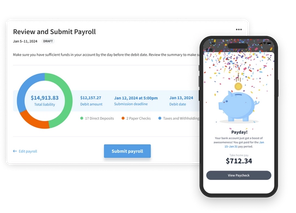
Eddy’s HR Mavericks Encyclopedia
The world's largest free encyclopedia of HR, with 700+ HR articles and podcasts.
Created by Eddy and our HR Mavericks community.
New Hire Paperwork
Once you hire a new employee, one of their first tasks is to complete new hire paperwork. This paperwork is essential for enrollment and tracking employee benefits, maintaining payroll, and legal compliance.
What is New Hire Paperwork?
New employee paperwork provides you with all the important information and documents you need to track about your employees. Some of these may be forms created by your organization and others are required by external sources such as the government or your benefit vendors. The employee completes these forms and submits them to HR to be stored in the employee's personnel file.
Why is New Hire Paperwork Important?
New hire paperwork gives your employees documentation outlining company expectations, policies, and procedures as well as ensuring compliance with certain employment regulations. Here are a few reasons to create a new hire packet.
- It will help employees become better acquainted with the company.
- Employees will feel connected to company culture from the start.
- The company will ensure compliance with relevant employment regulations.
Types of New Hire Paperwork
Some new hire paperwork will be internal and specific to your organization. Other paperwork is provided by external sources such as vendors and government agencies. Here are some of the most common new hire paperwork employer's use.
Internal Documents
- Employment application
- Offer letter
- Employment Contract
- Non-disclosure agreement
- Background check results
- Drug test results
- Equal employment opportunity (EEO) data
- Nondisclosure agreement
- Noncompete agreement
- Direct Deposit form
- Emergency Contact form
- Employee Handbook Acknowledgement
External Documents
- Form W-4 (federal)
- State Form W-4 (some states)
- Local tax withholding form (varies by municipality)
- Form I-9
- Benefit enrollment forms
What To Do With New Hire Paperwork
New hire paperwork can be stored on paper or electronically, including in your people management software. Regardless of how you process and store the paperwork, you need to ensure that all employee personal information is stored securely and confidentially to ensure the integrity, accuracy, and reliability of the documents. Employers should consider the security of employees’ personal information when determining how to retain and store completed new hire paperwork. Depending on the document, new hire paperwork will be processed and stored in different ways.
Payroll Withholding Forms
Any payroll-related forms such as the federal Form W-4, state withholding W-4, and local tax withholding form, should be reviewed and the information entered into your payroll system. These forms can be updated by employees at any time and copies of the updated forms maintained in the employee’s personnel file. Employees are responsible for ensuring their tax-related information is correct, including providing accurate withholding information on their withholding forms and Form W-4. You can assist the employee by reviewing the form instructions and providing guidance, but it is illegal for an employer to complete a W-4 for an employee. Also, employees must fill out and sign their own W-4 forms.
Internal Forms
Any forms created internally should be reviewed, the relevant information entered into your payroll and/or people management software and then stored in the employee’s personnel file.
Benefit Enrollment Forms
Benefit enrollment forms should be reviewed and then passed along to the benefit carrier in the method they require. After processing the enrollment, store a copy of the completed form in the employee’s personnel file.
Federal Form I-9
Employers are required to use the Form I-9 to verify the identity and employment authorization of anyone hired in the United States. All U.S. employers must properly complete a Form I-9 for each individual they hire in the U.S., including citizens and noncitizens. Both employees and employers (or the authorized representatives of the employer) must complete different sections of the form. Employers must retain each employee's completed Form I-9 as long as the employee is employed. Once an employee no longer works for the organization, HR must determine how long to retain and store the form, either three years after the date of hire or one year after the termination date, whichever is later. If there is ever an audit, Form I-9s must be presentable to government officials for inspection within three business days of the date they were requested, so they should be stored in a safe and accessible location. If you use the E-Verify system to verify employment eligibility, you and the employee still need to complete the Form I-9.
Topics

Suzi Tropiano, SHRM-SCP, PHR, GPHR
With over 25 years of Human Resource Management experience, Suzi Tropiano has worked in many industries including finance, manufacturing, construction, healthcare, information systems, technology, and professional services. Prior to starting Blueprint HRM, Suzi worked both as a senior HR leader in organizations as well as an external consultant. In both types of roles, she has been successful in setting up HR structure and systems at various stages of company growth both from start up to updating and reinventing existing systems.
Frequently asked questions
Other Related Terms
Eddy’s HR Mavericks Encyclopedia
New Hire Paperwork
Once you hire a new employee, one of their first tasks is to complete new hire paperwork. This paperwork is essential for enrollment and tracking employee benefits, maintaining payroll, and legal compliance.
What is New Hire Paperwork?
New employee paperwork provides you with all the important information and documents you need to track about your employees. Some of these may be forms created by your organization and others are required by external sources such as the government or your benefit vendors. The employee completes these forms and submits them to HR to be stored in the employee's personnel file.
Why is New Hire Paperwork Important?
New hire paperwork gives your employees documentation outlining company expectations, policies, and procedures as well as ensuring compliance with certain employment regulations. Here are a few reasons to create a new hire packet.
- It will help employees become better acquainted with the company.
- Employees will feel connected to company culture from the start.
- The company will ensure compliance with relevant employment regulations.
Types of New Hire Paperwork
Some new hire paperwork will be internal and specific to your organization. Other paperwork is provided by external sources such as vendors and government agencies. Here are some of the most common new hire paperwork employer's use.
Internal Documents
- Employment application
- Offer letter
- Employment Contract
- Non-disclosure agreement
- Background check results
- Drug test results
- Equal employment opportunity (EEO) data
- Nondisclosure agreement
- Noncompete agreement
- Direct Deposit form
- Emergency Contact form
- Employee Handbook Acknowledgement
External Documents
- Form W-4 (federal)
- State Form W-4 (some states)
- Local tax withholding form (varies by municipality)
- Form I-9
- Benefit enrollment forms
What To Do With New Hire Paperwork
New hire paperwork can be stored on paper or electronically, including in your people management software. Regardless of how you process and store the paperwork, you need to ensure that all employee personal information is stored securely and confidentially to ensure the integrity, accuracy, and reliability of the documents. Employers should consider the security of employees’ personal information when determining how to retain and store completed new hire paperwork. Depending on the document, new hire paperwork will be processed and stored in different ways.
Payroll Withholding Forms
Any payroll-related forms such as the federal Form W-4, state withholding W-4, and local tax withholding form, should be reviewed and the information entered into your payroll system. These forms can be updated by employees at any time and copies of the updated forms maintained in the employee’s personnel file. Employees are responsible for ensuring their tax-related information is correct, including providing accurate withholding information on their withholding forms and Form W-4. You can assist the employee by reviewing the form instructions and providing guidance, but it is illegal for an employer to complete a W-4 for an employee. Also, employees must fill out and sign their own W-4 forms.
Internal Forms
Any forms created internally should be reviewed, the relevant information entered into your payroll and/or people management software and then stored in the employee’s personnel file.
Benefit Enrollment Forms
Benefit enrollment forms should be reviewed and then passed along to the benefit carrier in the method they require. After processing the enrollment, store a copy of the completed form in the employee’s personnel file.
Federal Form I-9
Employers are required to use the Form I-9 to verify the identity and employment authorization of anyone hired in the United States. All U.S. employers must properly complete a Form I-9 for each individual they hire in the U.S., including citizens and noncitizens. Both employees and employers (or the authorized representatives of the employer) must complete different sections of the form. Employers must retain each employee's completed Form I-9 as long as the employee is employed. Once an employee no longer works for the organization, HR must determine how long to retain and store the form, either three years after the date of hire or one year after the termination date, whichever is later. If there is ever an audit, Form I-9s must be presentable to government officials for inspection within three business days of the date they were requested, so they should be stored in a safe and accessible location. If you use the E-Verify system to verify employment eligibility, you and the employee still need to complete the Form I-9.
Topics

Suzi Tropiano, SHRM-SCP, PHR, GPHR
With over 25 years of Human Resource Management experience, Suzi Tropiano has worked in many industries including finance, manufacturing, construction, healthcare, information systems, technology, and professional services. Prior to starting Blueprint HRM, Suzi worked both as a senior HR leader in organizations as well as an external consultant. In both types of roles, she has been successful in setting up HR structure and systems at various stages of company growth both from start up to updating and reinventing existing systems.
Frequently asked questions
Other Related Terms
Eddy's HR Newsletter
Sign up for our email newsletter for helpful HR advice and ideas.


